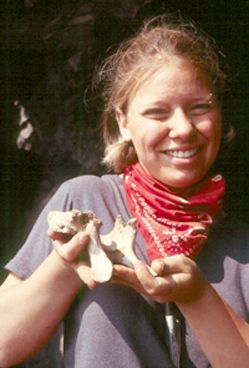Let’s hope to survive as long as our region’s ancients did
Published 8:00 pm Tuesday, October 14, 2014

- University of Oregon student Cassie Albush shows off a camel vertebra found in one of the Paisley caves.
When you start looking into it, there is an astounding amount of sagebrush included on the National Register of Historic Places.
It happens that Native American sites in the West often are well endowed with these aromatic desert plants. And this is the case with Paisley Five Mile Point Caves in south-central Oregon, which at the moment may be the most exciting location in the field of North American archaeology.
Whereas stone-age European caves are famous for elegant wildlife paintings, the Paisley caves’ claim to fame is — not to put too fine a point on it — poop. Known in technical jargon as coprolite, ancient human excrement is a rare survivor and a treasured way of dating when people were present at a site and what their diets were like.
Rigorous scientific techniques show that people were using parts of the caves as latrines 14,300 years ago, well before the first appearance of the famous Clovis culture. Clovis settlers, best known for their artistically chipped stone weapons, have been regarded as the original southbound wave of explorers on this continent. Originally identified in New Mexico, Clovis was very much a part of the Pacific Northwest’s prehistoric age. In 1987, farmworker Moises Aguirre Calzada uncovered a world-class 13,000-year-old cache of Clovis blades and other tools beside an irrigation project in East Wenatchee, Wash.
When talking of people who all lived almost unimaginably long ago, the 1,300 years between Paisley and Clovis may at first seem insubstantial. But this is the span of years between our times and the Dark Ages after the fall of the Roman Empire. A lot can happen in 1,300 years…
The Summer Lake Basin, where the Paisley caves are located, is still an appealing area — at least for those of us who appreciate empty spaces. Toward the end of the last ice age, the basin literally was a lake, with waves cutting the caves out of soft basalt cliffs at an elevation of 4,520 feet. As the climate dried, the lake started receding but was still within a mile of the caves when people arrived. Excavations over the past several summers by the University of Oregon’s Northern Great Basin Field School have found plenty of evidence that it was a good seasonal hunting camp, with ample wild game including camels and bison.
Manmade artifacts found in connection with the site are western stemmed projectiles, a much different technology than Clovis. Dennis Jenkins of the University of Oregon said, “It looks like you’ve got a separate group of people on the landscape, and these people are making different kinds of arrowheads or spear points.”
The passage of time, the submersion of the ancient coastline and the vastness of our region make discoveries this ancient rare as shark feathers. This means there may have been a far more complex pattern of migration than anyone can now guess. The age of the Paisley occupation raises the fascinating possibility that some Siberian or Arctic people may have come to this region well before the end of the ice age, either losing out to advancing glaciers or having evidence of their existence erased by the ice.
From somewhat more recent times, we’re beginning to see the faint outlines of other prehistoric settlers. In September, genetic researchers announced they had discovered a previously unknown migration of folks called the Saqqaq people, who came west across the Arctic to Greenland around 4,000 years ago and then died out without leaving any known descendants.
These and other clues suggest North America was nowhere near as unique a discovery in 1492 as elementary school teachers used to make out. Last week, the Seattle City Council voted to replace Columbus Day with Indigenous Peoples’ Day. Although this invites a degree of mirth about our perhaps overly enthusiastic urban neighbors, this symbolic step is a valuable reminder that Europeans are distinctly Johnnies-come-lately in the Americas.
“This action will allow us to bring into current present day our valuable and rich history, and it’s there for future generations to learn,” said Fawn Sharp, president of the Quinault Nation in Grays Harbor County. “Nobody discovered Seattle, Washington,” she said to a round of applause, according to an AP report.
The reality that human beings lived in the Pacific Northwest for at least 140 centuries before white settlers arrived is a powerful concept. They weren’t entirely benign — witness the absence of North American camels — but they certainly may be said to have lived within their environment in more sustainable ways than Europeans have managed.
As we fully enter into another age of climatic instability, we can only hope to survive as long the ancients did.
— M.S.W.
Matt Winters is editor of the Chinook Observer and Coast River Business Journal.
The Paisley caves’ claim to fame is — not to put too fine a point on it — poop.




